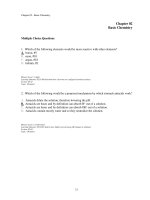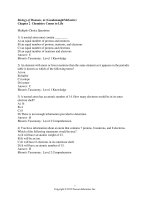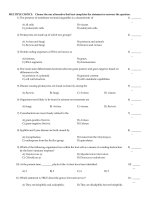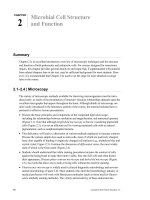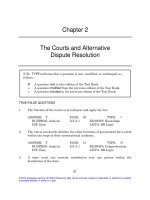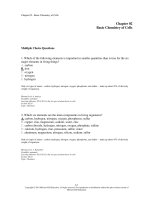Essentials of biology 4th edition mader test bank
Bạn đang xem bản rút gọn của tài liệu. Xem và tải ngay bản đầy đủ của tài liệu tại đây (267.29 KB, 25 trang )
Chapter 02 - The Chemical Basis of Life
Chapter 02
The Chemical Basis of Life
Multiple Choice Questions
1. Which of the following is not one of the most common elements in living things?
A. carbon
B. oxygen
C. hydrogen
D. iron
E. nitrogen
Six elements of matter make up the majority of body weight of most organisms. Their
presence and properties are essential to the uniqueness of living things.
Blooms Level: 1. Remember
Gradable: automatic
Learning Outcome: 02.01.01 Distinguish among the types, location, and charge of subatomic particles.
Section: 02.01
Topic: Chemistry
2. Which one of the following is the smallest unit of matter that has all the properties of an
element?
A. molecule
B. element
C. atom
D. compound
E. electron
Blooms Level: 1. Remember
Gradable: automatic
Learning Outcome: 02.01.01 Distinguish among the types, location, and charge of subatomic particles.
Section: 02.01
Topic: Chemistry
2-1
Copyright © 2015 McGraw-Hill Education. All rights reserved. No reproduction or distribution without the prior written consent of
McGraw-Hill Education.
Chapter 02 - The Chemical Basis of Life
3. Elements differ from each other in their
A. physical properties only.
B. atomic number only.
C. type of subatomic particles.
D. physical properties and atomic number.
E. type of electrons.
Blooms Level: 2. Understand
Gradable: automatic
Learning Outcome: 02.01.01 Distinguish among the types, location, and charge of subatomic particles.
Section: 02.01
Topic: Chemistry
4. Regarding atoms, identify which statement below is correct.
A. An element may be composed of several types of atoms.
B. The nucleus of an atom contains protons and electrons.
C. The number and arrangement of electrons in an atom governs its chemical activity.
D. The positive charges of an element are carried by the electrons.
E. The neutral charges of an element are carried by the protons.
Blooms Level: 3. Apply
Gradable: automatic
Learning Outcome: 02.01.01 Distinguish among the types, location, and charge of subatomic particles.
Section: 02.01
Topic: Chemistry
5. Isotopes of an element differ in their
A. proton number.
B. electron number.
C. neutron number.
D. type of bonds.
E. atomic number.
Blooms Level: 1. Remember
Gradable: automatic
Learning Outcome: 02.01.01 Distinguish among the types, location, and charge of subatomic particles.
Section: 02.01
Topic: Chemistry
2-2
Copyright © 2015 McGraw-Hill Education. All rights reserved. No reproduction or distribution without the prior written consent of
McGraw-Hill Education.
Chapter 02 - The Chemical Basis of Life
6. An atom's outermost electron shell
A. is filled when it has three electrons.
B. determines its chemical reactivity.
C. determines its atomic mass.
D. is filled with positively charged particles.
E. is filled identically for every element.
Blooms Level: 2. Understand
Gradable: automatic
Learning Outcome: 02.01.02 Relate how the arrangement of electrons determines an element's reactivity.
Section: 02.01
Topic: Chemistry
7. An atom that has an electrical charge is called a(n)
A. ion.
B. molecule.
C. isotope.
D. element.
E. proton.
Blooms Level: 1. Remember
Gradable: automatic
Learning Outcome: 02.01.01 Distinguish among the types, location, and charge of subatomic particles.
Section: 02.01
Topic: Chemistry
8. A covalent bond occurs when
A. protons are transferred from one atom to another.
B. neutrons are shared between two atoms to form an isotope.
C. electrons are shared between two atoms to complete their octets.
D. the hydrogen of one water molecule is attracted to the oxygen of another water molecule.
E. electrons are transferred from one atom to another.
Blooms Level: 2. Understand
Gradable: automatic
Learning Outcome: 02.01.04 Contrast ionic and covalent bonds.
Section: 02.01
Topic: Chemistry
2-3
Copyright © 2015 McGraw-Hill Education. All rights reserved. No reproduction or distribution without the prior written consent of
McGraw-Hill Education.
Chapter 02 - The Chemical Basis of Life
9. The type of bond that would form from the transfer of an electron from one atom to
another, as depicted in the figure, is a
A.
B.
C.
D.
E.
covalent.
ionic.
hydrogen.
atomic.
isotope.
Blooms Level: 2. Understand
Figure: 02.07a
Gradable: automatic
Learning Outcome: 02.01.04 Contrast ionic and covalent bonds.
Section: 02.01
Topic: Chemistry
10. Which of these does not occur when a sodium atom transfers an electron to a chlorine
atom?
A. The sodium atom becomes a positively charged ion.
B. The positive and negative ions will attract each other, forming a crystal if no water is
present.
C. The ions will separate in the presence of water.
D. There is a sharing of the electrons between the sodium and chlorine atoms.
E. The chlorine atom becomes a negatively charged ion.
Blooms Level: 3. Apply
Gradable: automatic
Learning Outcome: 02.01.04 Contrast ionic and covalent bonds.
Section: 02.01
Topic: Chemistry
2-4
Copyright © 2015 McGraw-Hill Education. All rights reserved. No reproduction or distribution without the prior written consent of
McGraw-Hill Education.
Chapter 02 - The Chemical Basis of Life
11. Which of the following is NOT a compound?
A. H2O
B. O2
C. NaCl
D. CO2
E. MgCl2
Blooms Level: 3. Apply
Gradable: automatic
Learning Outcome: 02.01.05 Identify the reactants and products in a chemical equation.
Section: 02.01
Topic: Chemistry
12. Glucose, C6H12O6, is best described as a(n)
A. element.
B. isotope.
C. compound.
D. ion.
E. charged atom.
Blooms Level: 2. Understand
Gradable: automatic
Learning Outcome: 02.01.05 Identify the reactants and products in a chemical equation.
Section: 02.01
Topic: Chemistry
2-5
Copyright © 2015 McGraw-Hill Education. All rights reserved. No reproduction or distribution without the prior written consent of
McGraw-Hill Education.
Chapter 02 - The Chemical Basis of Life
13. A water molecule, as shown here, is polar because of
A.
B.
C.
D.
E.
transfer of electrons.
unequal sharing of electrons.
its ability to freeze.
its hydrogen bonds.
its change in density when frozen.
Blooms Level: 2. Understand
Figure: 02.09a
Gradable: automatic
Learning Outcome: 02.02.01 Describe the general structure of a water molecule.
Section: 02.02
Topic: Chemistry
14. The figure below is depicting the interaction of water molecules with one another, which
involves the use of
A.
B.
C.
D.
E.
covalent bonds.
hydrogen bonds.
ionic bonds.
valence shells.
solvents.
Blooms Level: 2. Understand
Figure: 02.09b
Gradable: automatic
Learning Outcome: 02.02.01 Describe the general structure of a water molecule.
Section: 02.02
Topic: Chemistry
2-6
Copyright © 2015 McGraw-Hill Education. All rights reserved. No reproduction or distribution without the prior written consent of
McGraw-Hill Education.
Chapter 02 - The Chemical Basis of Life
15. Which of the following is NOT a property of water?
A. It is a good solvent.
B. It is denser when frozen than when liquid.
C. It is cohesive.
D. It resists temperature changes.
E. It can be found as a solid, liquid, or gas.
Blooms Level: 1. Remember
Gradable: automatic
Learning Outcome: 02.02.02 List the properties of water that are important to life.
Section: 02.02
Topic: Chemistry
16. Bases can
A. release only hydrogen ions.
B. take up only hydrogen ions.
C. release only hydroxide ions.
D. both take up hydrogen ions and release hydroxide ions.
E. release hydrogen and release hydroxide.
Blooms Level: 2. Understand
Gradable: automatic
Learning Outcome: 02.03.01 Distinguish between an acid and a base.
Section: 02.03
Topic: Chemistry
17. The pH scale is a mathematical indicator of
A. the concentration of H+ present in a solution.
B. the concentration of OH- present in a solution.
C. the total amount of all ions in a solution.
D. the ability of a solution to buffer.
E. the ability to dissolve in water.
Blooms Level: 2. Understand
Gradable: automatic
Learning Outcome: 02.03.02 Interpret the pH scale.
Section: 02.03
Topic: Chemistry
2-7
Copyright © 2015 McGraw-Hill Education. All rights reserved. No reproduction or distribution without the prior written consent of
McGraw-Hill Education.
Chapter 02 - The Chemical Basis of Life
18. After drinking a great deal of coffee (pH 5), a human's blood buffering system would
need to ______________ as the coffee was digested to lower the level of acid present in the
blood stream.
A. release OHB. take up H+
C. release H+
D. take up OHE. release OH- and take up H+
Blooms Level: 3. Apply
Gradable: automatic
Learning Outcome: 02.03.03 Explain the purpose of a buffer.
Section: 02.03
Topic: Chemistry
19. The term to describe any substance, which can prevent the pH of a solution from
changing by either releasing or absorbing H+ in a solution is
A. equalizer.
B. solute.
C. buffer.
D. acid.
E. base.
Blooms Level: 1. Remember
Gradable: automatic
Learning Outcome: 02.03.03 Explain the purpose of a buffer.
Section: 02.03
Topic: Chemistry
2-8
Copyright © 2015 McGraw-Hill Education. All rights reserved. No reproduction or distribution without the prior written consent of
McGraw-Hill Education.
Chapter 02 - The Chemical Basis of Life
20. Which of the following would be an example of the value of water's heat capacity?
A. Water is able to travel up a 100 foot tree.
B. Water expands as it freezes causing ice to float on the surface of a lake.
C. Living organisms are better able to maintain their internal body temperature because the
temperature of their environment changes very slowly.
D. Small insects can walk on water.
E. Ice cubes float.
Blooms Level: 4. Analyze
Gradable: automatic
Learning Outcome: 02.02.02 List the properties of water that are important to life.
Section: 02.02
Topic: Chemistry
21. What property of water causes sugar to dissolve in coffee?
A. Water has high heat capacity.
B. Water is less dense as ice.
C. Water is a good solvent.
D. Water is cohesive.
E. Water is able to change states.
Blooms Level: 3. Apply
Gradable: automatic
Learning Outcome: 02.02.02 List the properties of water that are important to life.
Section: 02.02
Topic: Chemistry
22. Which of the following explains the events occurring when water boils?
A. Hydrogen bonds are broken between neighbor water molecules.
B. Covalent bonds are broken between oxygen and hydrogen atoms.
C. Ionic bonds are broken when the minerals in water are heated.
D. The bond between one water molecule and another is strengthened.
E. The hydrogen atoms break away from the oxygen and escape as vapor.
Blooms Level: 5. Evaluate
Gradable: automatic
Learning Outcome: 02.02.03 Understand the importance of hydrogen bonds to the properties of water.
Section: 02.02
Topic: Chemistry
2-9
Copyright © 2015 McGraw-Hill Education. All rights reserved. No reproduction or distribution without the prior written consent of
McGraw-Hill Education.
Chapter 02 - The Chemical Basis of Life
23. What is the steam being given off when water boils?
A. oxygen molecules
B. hydrogen molecules
C. water molecules
D. hydroxide (OH-) ions
E. hydrogen (H+) ion
Blooms Level: 5. Evaluate
Gradable: automatic
Learning Outcome: 02.02.01 Describe the general structure of a water molecule.
Section: 02.02
Topic: Chemistry
24. Which property of water would help to account for how an individual who is exercising
and producing excessive heat can maintain a constant body temperature?
A. Water has high heat capacity.
B. Water is less dense as ice.
C. Water is a good solvent.
D. Water is cohesive.
E. Water molecules form by covalent bonding.
Blooms Level: 5. Evaluate
Gradable: automatic
Learning Outcome: 02.02.02 List the properties of water that are important to life.
Section: 02.02
Topic: Chemistry
25. If average temperatures from South Dakota were compared to temperatures from Oregon
it would show that Oregon has warmer winters and cooler summers than South Dakota does.
What accounts for why this is when they are at similar latitudes?
A. South Dakota has fewer trees.
B. The Pacific ocean makes Oregon temperatures more moderate.
C. Oregon receives more rainfall.
D. South Dakota has fewer lakes and rivers.
E. South Dakota has more prevailing winds from the west.
Blooms Level: 4. Analyze
Gradable: automatic
Learning Outcome: 02.02.02 List the properties of water that are important to life.
Section: 02.02
Topic: Chemistry
2-10
Copyright © 2015 McGraw-Hill Education. All rights reserved. No reproduction or distribution without the prior written consent of
McGraw-Hill Education.
Chapter 02 - The Chemical Basis of Life
26. How do a strong acid and a weak acid differ?
A. A strong acid has less H+ in solution.
B. A weak acid dissociates only partially in water.
C. A strong acid is less likely to remain dissociated.
D. A weak acid dissociates nearly completely in water.
E. A strong acid dissociates only partly in water.
Blooms Level: 2. Understand
Gradable: automatic
Learning Outcome: 02.03.01 Distinguish between an acid and a base.
Section: 02.03
Topic: Chemistry
27. Baking soda is sometimes used as an antacid. The chemical name for baking soda is
Sodium Bicarbonate. What is the bicarbonate doing to help with stomach upset?
A. It is serving as a buffer to take up excess H+ ion from stomach acid.
B. It is able to coat the stomach lining.
C. The bicarbonate helps to create more acid in the stomach.
D. The bicarbonate acts as a strong acid quickly dissociating into H+ ion.
E. It relaxes the stomach muscles.
Blooms Level: 5. Evaluate
Gradable: automatic
Learning Outcome: 02.03.03 Explain the purpose of a buffer.
Section: 02.03
Topic: Chemistry
28. Which of the following is not a contributing event in the formation of acid rain?
A. Fossil fuels consume oxygen removing it from the atmosphere.
B. Coal & oil emit sulfur dioxide and nitrogen oxide when they are burned.
C. Fossil fuel emission gases combine with water in the atmosphere.
D. A solution of sulfuric acid and nitric acid forms.
E. Precipitation containing sulfuric acid and nitric acid fall to the Earth.
Blooms Level: 2. Understand
Gradable: automatic
Learning Outcome: 02.03.01 Distinguish between an acid and a base.
Section: 02.03
Topic: Chemistry
2-11
Copyright © 2015 McGraw-Hill Education. All rights reserved. No reproduction or distribution without the prior written consent of
McGraw-Hill Education.
Chapter 02 - The Chemical Basis of Life
29. What do lemons, tomatoes, and coffee all have in common chemically?
A. They are all foods that people consume.
B. They all produce (H+) in solution, making them acids.
C. They all are fruits.
D. They all taste bitter.
E. They are all slippery to the touch.
Blooms Level: 3. Apply
Gradable: automatic
Learning Outcome: 02.03.01 Distinguish between an acid and a base.
Section: 02.03
Topic: Chemistry
30. Of the following examples which best demonstrates the property of water cohesion?
A. Water can move up a 100 foot pine tree from the roots to the leaves.
B. A rock skipping across the surface of a lake.
C. Water requires a great deal of heat to reach the point of vaporizing.
D. A soda can bursts when it is placed in the freezer.
E. A large body of fresh water takes a long time to warm up after the winter season.
Blooms Level: 4. Analyze
Gradable: automatic
Learning Outcome: 02.02.02 List the properties of water that are important to life.
Section: 02.02
Topic: Chemistry
31. When hot chocolate mix is added to water the hot chocolate is the ______ and the water is
the ________.
A. solvent; solute
B. molecule; compound
C. solute; solvent
D. compound; molecule
E. element; compound
Blooms Level: 2. Understand
Gradable: automatic
Learning Outcome: 02.02.02 List the properties of water that are important to life.
Section: 02.02
Topic: Chemistry
2-12
Copyright © 2015 McGraw-Hill Education. All rights reserved. No reproduction or distribution without the prior written consent of
McGraw-Hill Education.
Chapter 02 - The Chemical Basis of Life
32. A coke has a pH of 3.5. This means that it has an excess of _______ ions and would be
called a(n) _____.
A. H+; acid
B. OH-; acid
C. H+; base
D. OH-; base
E. H+; neutral solution
Blooms Level: 2. Understand
Gradable: automatic
Learning Outcome: 02.03.02 Interpret the pH scale.
Section: 02.03
Topic: Chemistry
33. Isotopes of an atom differ in their
A. atomic number.
B. atomic mass.
C. number of electrons.
D. atomic radius.
E. number of protons.
Blooms Level: 2. Understand
Gradable: automatic
Learning Outcome: 02.01.03 Explain how isotopes are useful in the study of biology.
Section: 02.01
Topic: Chemistry
34. Which of the following is a property of acids?
A. release hydrogen ions when dissolved in a liquid
B. feel slippery when touched
C. taste bitter
D. release hydroxide ions when dissolved in a liquid
E. have a pH reading above 7.0
Blooms Level: 2. Understand
Gradable: automatic
Learning Outcome: 02.03.01 Distinguish between an acid and a base.
Section: 02.03
Topic: Chemistry
2-13
Copyright © 2015 McGraw-Hill Education. All rights reserved. No reproduction or distribution without the prior written consent of
McGraw-Hill Education.
Chapter 02 - The Chemical Basis of Life
Matching Questions
35. Use the following terms to match the statements provided.
1. Their number in an atom is the atomic number of the element
2. Created when an atom either loses or gains electrons in a
reaction, resulting in an overall net charge
3. Their number and arrangement determine which chemical
reactions an element can take part in
4. The smallest particle of an element that retains the properties of
that element
5. Their numbers will vary in isotopes of the same element
Ion
2
Atom
4
Electron
3
Proton 1
Neutron
5
Blooms Level: 2. Understand
Gradable: automatic
Learning Outcome: 02.01.01 Distinguish among the types, location, and charge of subatomic particles.
Section: 02.01
Topic: Chemistry
Multiple Choice Questions
36. An element has an atomic number of 78. The number of protons and electrons in a neutral
atom of the element are
A. 156 protons and 78 electrons.
B. 39 protons and 39 electrons.
C. 78 protons and 0 electrons.
D. 78 protons and 78 electrons.
E. 78 protons and 39 electrons.
Blooms Level: 2. Understand
Gradable: automatic
Learning Outcome: 02.01.01 Distinguish among the types, location, and charge of subatomic particles.
Section: 02.01
Topic: Chemistry
2-14
Copyright © 2015 McGraw-Hill Education. All rights reserved. No reproduction or distribution without the prior written consent of
McGraw-Hill Education.
Chapter 02 - The Chemical Basis of Life
37. All atoms of the same element have the same
A. number of neutrons.
B. atomic number.
C. number of electrons.
D. atomic mass.
E. number of ions.
Blooms Level: 1. Remember
Gradable: automatic
Learning Outcome: 02.01.01 Distinguish among the types, location, and charge of subatomic particles.
Section: 02.01
Topic: Chemistry
38. In what ways are radioactive isotopes potentially harmful?
A. Unmonitored release into the environment can make changes in a cell's DNA.
B. They are used to trace molecular changes.
C. They are used to destroy abnormal cells.
D. They are used to determine the age of biological specimens.
E. They are used to trace the path of materials throughout the body.
Blooms Level: 2. Understand
Gradable: automatic
Learning Outcome: 02.01.03 Explain how isotopes are useful in the study of biology.
Section: 02.01
Topic: Chemistry
39. The number of neutrons in the nucleus of an average atom of an element is best estimated
by
A. adding the number of electrons and protons together.
B. subtracting the number of electrons from the number of protons.
C. adding the mass number to the number of electrons.
D. subtracting the number of protons from the mass number.
E. adding the atomic number and atomic mass together.
Blooms Level: 1. Remember
Gradable: automatic
Learning Outcome: 02.01.01 Distinguish among the types, location, and charge of subatomic particles.
Section: 02.01
Topic: Chemistry
2-15
Copyright © 2015 McGraw-Hill Education. All rights reserved. No reproduction or distribution without the prior written consent of
McGraw-Hill Education.
Chapter 02 - The Chemical Basis of Life
40. Students were studying properties of water. One student placed a cup containing 80 mL of
water in a freezer. Another student placed an identical cup containing 40 mL of water in the
same freezer. Which of the following will be the same for both cups of water?
A. the temperature at which the water freezes
B. the mass of the frozen water
C. the time it takes the water to freeze
D. the volume of the frozen water
E. the space it occupies in the cups
Blooms Level: 5. Evaluate
Gradable: automatic
Learning Outcome: 02.02.02 List the properties of water that are important to life.
Section: 02.02
Topic: Chemistry
41. Engineers design city sidewalks using blocks of concrete separated by a small gap to
prevent them from cracking. What property of water is being taken into account for this
design? Water
A. is a good solvent.
B. is less dense when it is frozen.
C. is cohesive.
D. is resistant to temperature changes.
E. has a high heat capacity.
Blooms Level: 3. Apply
Gradable: automatic
Learning Outcome: 02.02.02 List the properties of water that are important to life.
Section: 02.02
Topic: Chemistry
2-16
Copyright © 2015 McGraw-Hill Education. All rights reserved. No reproduction or distribution without the prior written consent of
McGraw-Hill Education.
Chapter 02 - The Chemical Basis of Life
42. An atom with a neutral charge has
A. equal numbers of neutrons and electrons.
B. more neutrons making it more neutral.
C. the same number of protons and neutrons.
D. equal numbers of protons and electrons.
E. more protons than it does electrons.
Blooms Level: 1. Remember
Gradable: automatic
Learning Outcome: 02.01.01 Distinguish among the types, location, and charge of subatomic particles.
Section: 02.01
Topic: Chemistry
43. The atomic structure of water satisfies the octet rule by
A. having electrons shared between the two oxygen atoms.
B. having electrons from hydrogen transferred to the oxygen atom.
C. having electrons from oxygen transferred to the hydrogen atoms.
D. having oxygen share electrons with two hydrogen atoms.
E. having electrons shared between the two hydrogen atoms.
Blooms Level: 3. Apply
Gradable: automatic
Learning Outcome: 02.01.02 Relate how the arrangement of electrons determines an element's reactivity.
Section: 02.01
Topic: Chemistry
44. Which of the following would not be a valuable use for radioactive isotopes?
A. carbon-14 dating
B. destroying abnormal cells as a type of cancer treatment
C. tracing the path of various chemicals in the body for imaging
D. determining the age of biological specimens
E. damaging DNA of healthy cells.
Blooms Level: 2. Understand
Gradable: automatic
Learning Outcome: 02.01.03 Explain how isotopes are useful in the study of biology.
Section: 02.01
Topic: Chemistry
2-17
Copyright © 2015 McGraw-Hill Education. All rights reserved. No reproduction or distribution without the prior written consent of
McGraw-Hill Education.
Chapter 02 - The Chemical Basis of Life
45. In the reaction 6CO2 + 6H2O C6H12O6 + 6O2 carbon dioxide is one of the
A. reactants.
B. products.
C. enzymes.
D. elements.
E. catalysts.
Blooms Level: 2. Understand
Gradable: automatic
Learning Outcome: 02.01.05 Identify the reactants and products in a chemical equation.
Section: 02.01
Topic: Chemistry
46. Why do cells need buffering agents?
A. to minimize the changes in pH of their internal environment
B. to operate at a constant pH of 2.0
C. to carry out life functions in extremely acidic conditions
D. to help transfer electrons from one atom to another
E. to increase the amount of OH- in their surroundings
Blooms Level: 2. Understand
Gradable: automatic
Learning Outcome: 02.03.03 Explain the purpose of a buffer.
Section: 02.03
Topic: Chemistry
47. Which of the following is not a way in which chemical bonds can be formed?
A. sharing electrons
B. losing electrons
C. splitting electrons
D. gaining electrons
E. attractions of opposite charge
Blooms Level: 4. Analyze
Gradable: automatic
Learning Outcome: 02.01.04 Contrast ionic and covalent bonds.
Section: 02.01
Topic: Chemistry
2-18
Copyright © 2015 McGraw-Hill Education. All rights reserved. No reproduction or distribution without the prior written consent of
McGraw-Hill Education.
Chapter 02 - The Chemical Basis of Life
48. Sulfur has an atomic number of 16. What would be the valence number of this
element?1_01_2012
A. One
B. Two
C. Three
D. Four
E. Six
Blooms Level: 4. Analyze
Gradable: automatic
Learning Outcome: 02.01.02 Relate how the arrangement of electrons determines an element's reactivity.
Section: 02.01
Topic: Chemistry
49. Some insects can stride on the surface of water because water
A. has a high specific heat.
B. has lower density when frozen.
C. is a good solvent.
D. has surface tension.
E. resists temperature changes.
Blooms Level: 2. Understand
Gradable: automatic
Learning Outcome: 02.02.02 List the properties of water that are important to life.
Section: 02.02
Topic: Chemistry
50. The pH of pure water is ______ because ___________________________.
A. 7.0; water dissociates an equal number of H+ ions and OHB. 14.0; water dissociates and more OH- is formed because there are more hydrogen atoms in
water
C. 1.0; water dissociates and more H+ is formed since hydrogen is smaller and can separate
from the oxygen easily
D. 7.0; there are no ions formed in pure water
E. acidic; there are more H+ ions than OH- ions present
Blooms Level: 2. Understand
Gradable: automatic
Learning Outcome: 02.03.02 Interpret the pH scale.
Section: 02.03
Topic: Chemistry
2-19
Copyright © 2015 McGraw-Hill Education. All rights reserved. No reproduction or distribution without the prior written consent of
McGraw-Hill Education.
Chapter 02 - The Chemical Basis of Life
51. Which of the following best describes the structure of how water molecules form and
interact?
A. Hydrogen atoms bond with each other to create stable outer shell of electrons. Then they
form a hydrogen bond to an oxygen atom to create the water molecule.
B. Oxygen atoms transfer one electron to each of the hydrogen atoms forming an ionic bond
that attracts other water molecules to it.
C. The oxygen atom and hydrogen atoms form a covalent bond with one another to create
stable outer shells of electrons. The electrons are shared unequally resulting in a polar
molecule whose slight charges form weak hydrogen bond attractions with other water
molecules.
D. Hydrogen bonds are formed between the two hydrogen atoms and the oxygen atom. This
water molecule than forms a covalent bond with adjacent water molecules.
E. The oxygen atom is more electronegative than the two hydrogen atoms. Due to this, it
removes the electron from each hydrogen atom. This satisfies the outer shell of oxygen. Then
hydrogen bonds form between the two remaining hydrogen atoms to hold them near to the
oxygen atom.
Blooms Level: 5. Evaluate
Gradable: automatic
Learning Outcome: 02.02.01 Describe the general structure of a water molecule.
Section: 02.02
Topic: Chemistry
52. The particles that are found in the nucleus of an atom are the
A. protons and electrons.
B. neutrons and protons.
C. electrons only.
D. protons only.
E. electrons and neutrons.
Blooms Level: 1. Remember
Gradable: automatic
Learning Outcome: 02.01.01 Distinguish among the types, location, and charge of subatomic particles.
Section: 02.01
Topic: Chemistry
2-20
Copyright © 2015 McGraw-Hill Education. All rights reserved. No reproduction or distribution without the prior written consent of
McGraw-Hill Education.
Chapter 02 - The Chemical Basis of Life
53. Which of these is a property of isotopes that make it useful in cell biology?
A. they never breakdown
B. they behave the same chemically
C. they behave differently chemically
D. the molecules they are part of break down more easily
E. the molecules they are part of are more stable
Blooms Level: 4. Analyze
Gradable: automatic
Learning Outcome: 02.01.03 Explain how isotopes are useful in the study of biology.
Section: 02.01
Topic: Chemistry
54. Radioactive isotopes are useful in biological studies because
A. an organism will take in a molecule with the isotope and use it normally but the radioactive
decay can be detected.
B. an organism will take in a molecule with the isotope but will only use it in a few specific
reactions not the normal ones.
C. an organism will take in the molecule with the isotope and then remove the isotope and
send it through the excretory system while replacing the isotope with a normal atom.
D. they are easily visible and normal atoms are not.
E. they are easy and inexpensive to use in studies.
Blooms Level: 4. Analyze
Gradable: automatic
Learning Outcome: 02.01.03 Explain how isotopes are useful in the study of biology.
Section: 02.01
Topic: Chemistry
55. The reactivity of an atom depends on
A. the number of protons.
B. the number of neutrons.
C. the number of electrons.
D. the number of valence electrons.
E. the number of protons and neutrons in the nucleus.
Blooms Level: 2. Understand
Gradable: automatic
Learning Outcome: 02.01.02 Relate how the arrangement of electrons determines an element's reactivity.
Section: 02.01
Topic: Chemistry
2-21
Copyright © 2015 McGraw-Hill Education. All rights reserved. No reproduction or distribution without the prior written consent of
McGraw-Hill Education.
Chapter 02 - The Chemical Basis of Life
56. Chemical bonds involve
A. the giving and taking of electrons.
B. the giving and taking of protons.
C. the giving, taking or sharing of electrons.
D. the giving, taking or sharing of protons.
E. the sharing of electrons.
Blooms Level: 2. Understand
Gradable: automatic
Learning Outcome: 02.01.02 Relate how the arrangement of electrons determines an element's reactivity.
Section: 02.01
Topic: Chemistry
57. The electron arrangement for argon, which has 18 electrons, is
A. 2 in the inner energy shell, 8 in the second energy shell and 8 in the outer energy shell
B. 8 in the inner energy shell, 8 in the second energy shell and 2 in the outer energy shell
C. 6 in the inner energy shell, 6 in the second energy shell and 6 in the outer energy shell
D. 5 in the inner energy shell, 6 in the second energy shell and 7 in the outer energy shell
E. 7 in the inner energy shell, 6 in the second energy shell and 5 in the outer energy shell
Blooms Level: 3. Apply
Gradable: automatic
Learning Outcome: 02.01.02 Relate how the arrangement of electrons determines an element's reactivity.
Section: 02.01
Topic: Chemistry
58. Inside a living cell, which type of bond would be the most stable?
A. hydrogen
B. ionic
C. covalent
D. polar
E. all bonds are equally stable in a living system
Blooms Level: 5. Evaluate
Gradable: automatic
Learning Outcome: 02.01.04 Contrast ionic and covalent bonds.
Section: 02.01
Topic: Chemistry
2-22
Copyright © 2015 McGraw-Hill Education. All rights reserved. No reproduction or distribution without the prior written consent of
McGraw-Hill Education.
Chapter 02 - The Chemical Basis of Life
59. An ionic bond forms when
A. an atom gives away or takes in an electron.
B. an atom gives away or takes in a proton.
C. a negatively charged ion is attracted to one with a positive charge.
D. two atoms come close enough to share one or more electrons.
E. two atoms come close enough to share one or more protons.
Blooms Level: 3. Apply
Gradable: automatic
Learning Outcome: 02.01.04 Contrast ionic and covalent bonds.
Section: 02.01
Topic: Chemistry
60. A covalent bond involves the sharing of
A. electrons.
B. protons.
C. pairs of protons.
D. at least 3 electrons.
E. pairs of electrons.
Blooms Level: 3. Apply
Gradable: automatic
Learning Outcome: 02.01.04 Contrast ionic and covalent bonds.
Section: 02.01
Topic: Chemistry
2-23
Copyright © 2015 McGraw-Hill Education. All rights reserved. No reproduction or distribution without the prior written consent of
McGraw-Hill Education.
Chapter 02 - The Chemical Basis of Life
61. Which of the following describe how an acid disrupts the chemical bonds of molecules in
a cell?
A. the H+ ions can disrupt hydrogen bonds as the slightly negative portion of the molecule is
more attracted to it than to the hydrogen that was part of the bond.
B. the H+ ions can disrupt hydrogen bonds as the slightly positive portion of the molecule is
more attracted to it than to the hydrogen that was part of the bond.
C. the OH- ions can disrupt hydrogen bonds as the slightly positive portion of the molecule is
more attracted to it than to the hydrogen that was part of the bond.
D. the OH- ions can disrupt hydrogen bonds as the slightly negative portion of the molecule is
more attracted to it than to the hydrogen that was part of the bond.
E. The H+ ions disrupt the covalent bonds that hold the molecule together.
Blooms Level: 5. Evaluate
Gradable: automatic
Learning Outcome: 02.03.01 Distinguish between an acid and a base.
Section: 02.03
Topic: Chemistry
62. You are caring for the freshwater aquarium of a friend while they are on vacation. You are
told to check the pH of the tank and make sure that it stays between 6.5 and 7.0. When you
check the water the pH is 8.0. The water in the tank is
A. 1 to 1.5 times more basic than it should be.
B. 1 to 1.5 times more acidic than it should be.
C. 10 to 15 times more basic than it should be.
D. 10 to 15 times more acidic than it should be.
E. 100 to 150 times more basic than it should be.
Blooms Level: 5. Evaluate
Gradable: automatic
Learning Outcome: 02.03.02 Interpret the pH scale.
Section: 02.03
Topic: Chemistry
2-24
Copyright © 2015 McGraw-Hill Education. All rights reserved. No reproduction or distribution without the prior written consent of
McGraw-Hill Education.
Chapter 02 - The Chemical Basis of Life
63. You are caring for the freshwater aquarium of a friend while they are on vacation. You
are told to check the pH of the tank and make sure that it stays between 6.5 and 7.0. In order
to ensure that you do not have to worry about the pH you
A. treat the fish and the tank with aspirin.
B. add NaOH so that changes in the tank are calculated.
C. add HCl so that you can track the changes in the tank’s pH.
D. do nothing since the pH will not change unless you do something wrong and you plan to
follow the directions exactly.
E. add a buffer so changes in pH are minimized.
Blooms Level: 5. Evaluate
Gradable: automatic
Learning Outcome: 02.03.03 Explain the purpose of a buffer.
Section: 02.03
Topic: Chemistry
64. Which of the following is not a property of water that results from hydrogen bonding?
A. Ice melts at -100C.
B. The temperature of water changes very slowly.
C. Many polar substances dissolve in water.
D. Water molecules have cohesiveness.
E. Water has a high surface tension.
Blooms Level: 1. Remember
Gradable: automatic
Learning Outcome: 02.02.03 Understand the importance of hydrogen bonds to the properties of water.
Section: 02.02
Topic: Chemistry
2-25
Copyright © 2015 McGraw-Hill Education. All rights reserved. No reproduction or distribution without the prior written consent of
McGraw-Hill Education.
